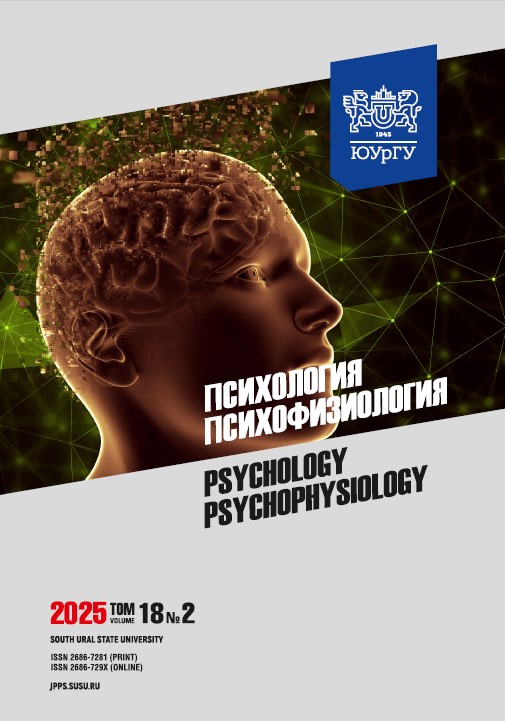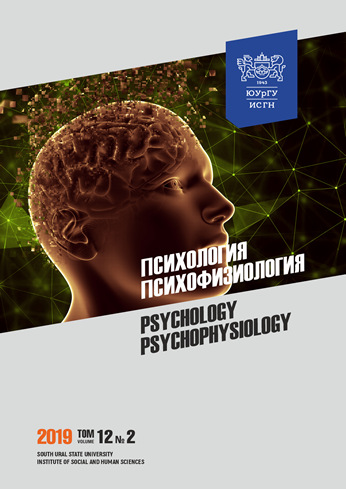Компьютерные игры как среда для психологических исследований
Аннотация
Компьютерные игры (КИ) – особый вид технологического медиа (цифровой среды), для которого характерно наличие динамичного контекста, трансформирующегося под влиянием действий игрока и встроенных алгоритмов. В рамках психологических исследований КИ предоставляют более естественные условия для изучения ряда явлений по сравнению с компьютеризированными лабораторными тестами. Кроме того, КИ оказывают влияние на психические процессы. Перечисленные особенности широко используются в зарубежных психологических исследованиях, рассмотрение которых представляется важным для определения актуальных направлений будущих работ. Цель. Цель работы заключается в определении перспектив использования КИ как цифровой среды для исследования психических процессов и межличностного взаимодействия. Теоретические основы. В зарубежных научных базах данных был проведен несистематический поиск психологических исследований компьютерных игр и компьютерного спорта с выделением таких феноменов, как восприятие времени, внимание, принятие решений, состояние потока, межличностная синхронизация, командные процессы и командное мышление. При анализе зарубежных исследований использовался описательный подход, а также метод включения нового знания путем проведения аналогии между деятельностью человека в КИ и других видах активности, рассматриваемых в смежных областях науки. Результаты. Преимуществами КИ как среды для психологических исследований являются динамическая регуляция уровня сложности задач, точная интерпретация игровых ситуаций и действий игрока и возможность использования психофизиологических методов в процессе игры. КИ требуют вовлечения ключевых психических процессов, что в долгосрочной перспективе приводит к их трансформации и открывает возможности для изучения подлежащих механизмов нейропластичности. КИ являются способом коммуникации и координации и выступают не только средством для взаимодействия человека и технологии, но и взаимодействия людей между собой в командном контексте. При этом число исследований, рассматривающих различные аспекты психической реальности и происходящих социальных процессов непосредственно во время КИ, крайне мало. Заключение. Полученные результаты свидетельствуют о перспективности использования КИ в качестве экологически валидной среды для психологических исследований, особенно при рассмотрении роли опосредованной технологиями реальности в психической и социальной деятельности человека
Скачивания
Литература
2. Sörman D.E., Dahl K.E., Lindmark D. et al. Relationships between Dota 2 expertise and decision-making ability. PloS one. 2022;17(3):e0264350. DOI: 10.1371/journal.pone.0264350
3. Pluss M.A., Bennett K.J.M., Novak A.R. et al. Esports: The Chess of the 21st Century. Frontiers in psychology. 2019;10. DOI: 10.3389/fpsyg.2019.00156
4. Bavelier D., Green C.S. Enhancing Attentional Control: Lessons from Action Video Games. Neuron. 2019;104(1):147–163. DOI: 10.1016/j.neuron.2019.09.031
5. Kozhevnikov M., Li Y., Wong S., Obana T., Amihai I. Do enhanced states exist? Boosting cognitive capacities through an action video-game. Cognition. 2018;173:93–105. DOI: 10.1016/j.cognition.2018.01.006
6. Bediou B., Adams D.M., Mayer R.E. et al. Meta-analysis of action video game impact on perceptual, attentional, and cognitive skills. Psychological bulletin. 2018;144(1): 77-110. DOI: 10.1037/bul0000130
7. Smirni D., Garufo E., Di Falco L., Lavanco G. The Playing Brain. The Impact of Video Games on Cognition and Behavior in Pediatric Age at the Time of Lockdown: A Systematic Review. Pediatric Reports. 2021;13(3):401–415. DOI: 10.3390/pediatric13030047
8. Toth A.J., Ramsbottom N., Kowal M., Campbell M.J. Converging Evidence Supporting the Cognitive Link between Exercise and Esport Performance: A Dual Systematic Review. Brain Sciences. 2020;10(11):859. DOI: 10.3390/brainsci10110859
9. Proceedings of the AHFE 2021 Virtual Conferences on Neuroergonomics and Cognitive Engineering, Industrial Cognitive Ergonomics and Engineering Psychology, and Cognitive Computing and Internet of Things. 2021. USA. 2021. Springer.
10. Khoshnoud S., Alvarez Igarzábal F., Wittmann M. Peripheral-physiological and neural correlates of the flow experience while playing video games: a comprehensive review. PeerJ. 2020;8:e10520. DOI: 10.7717/peerj.10520
11. Shehata M., Cheng M., Leung A. et al. Team Flow Is a Unique Brain State Associated with Enhanced Information Integration and Interbrain Synchrony. eNeuro. 2021;8(5). DOI: 10.1523/eneuro.0133-21.2021
12. de Sampaio Barros M.F., Araújo-Moreira F.M., Trevelin L.C., Radel R. Flow experience and the mobilization of attentional resources. Cognitive, Affective and Behavioral Neuroscience. 2018;18(4):810–823. DOI: 10.3758/s13415-018-0606-4
13. Ju U., Wallraven C. Manipulating and decoding subjective gaming experience during active gameplay: a multivariate, whole-brain analysis. Neuroimage. 2019;188:1–13. DOI: 10.1016/j.neuroimage.2018.11.061
14. Ardha A., Arif M., Nurhasan N. et al. The Development of Esports Research and Technology in the Last 3 Decades. TEM Journal. 2024;13(2). DOI: 10.18421/TEM132-67
15. Burelli P., Dixen L. Playing With Neuroscience: Past, Present and Future of Neuroimaging and Games. arXiv preprint arXiv:240315413. 2024. DOI: 10.48550/arXiv.2403.15413
16. Wittmann M., Paulus M.P. Temporal horizons in decision making. Journal of Neuroscience, Psychology and Economics. 2009;2(1):1. DOI: 10.1037/a0015460
17. Bogon J., Halbhuber D. Time and Timing in Video Games: How Video Game and Time Perception Research can benefit each other. Mensch und Computer 2023 – Workshopband. 2023. DOI: 10.18420/muc2023-mci-ws05-439
18. Hanson C. Game time: Understanding temporality in video games: Indiana University Press; 2018.
19. Lahdenperä L. “Live-Die-Repeat”. The Time Loop as a Narrative and a Game Mechanic. International Journal of Transmedia Literacy (IJTL). 2018;4:137–159. DOI: 10.7358/ijtl-2018-006-lahd
20. Rivero T.S., Covre P., Reyes M.B., Bueno O.F. Effects of chronic video game use on time perception: differences between sub- and multi-second intervals. Cyberpsychology, Behavior and Social Networking. 2013;16(2):140–144. DOI: 10.1089/cyber.2012.0103
21. Rutrecht H., Wittmann M., Khoshnoud S., Alvarez I.F. Time Speeds Up During Flow States: A Study in Virtual Reality with the Video Game Thumper. Timing and Time Perception. 2021;9(4):353–376. DOI: 10.1163/22134468-bja10033
22. Barton A.C., Sheen J., Byrne L.K. Immediate Attention Enhancement and Restoration From Interactive and Immersive Technologies: A Scoping Review. Frontiers in psychology. 2020;11:2050. DOI: 10.3389/fpsyg.2020.02050
23. Petilli M.A., Rinaldi L., Trisolini D.C. et al. How difficult is it for adolescents to maintain attention? The differential effects of video games and sports. Quarterly Journal of Experimental Psychology. 2020;73(6):968–982. DOI: 10.1177/1747021820908499
24. Apperley T.H. Genre and game studies: Toward a critical approach to video game genres. Simulation and Gaming. 2006;37(1):6–23. DOI: 10.1177/1046878105282278
25. Choi E., Shin S.-H., Ryu J.-K. et al. Commercial video games and cognitive functions: video game genres and modulating factors of cognitive enhancement. Behavioral and Brain Functions. 2020;16(1):1–14. DOI: 10.1186/s12993-020-0165-z
26. Rambhiya K., Lokesh L. Cognitive Flexibility, Leadership style on Decision Making among Self Employed and Employed. International Journal of Indian Psychȯlogy. 2023;11(2). DOI: 10.25215/1102.252
27. Dale G., Joessel A., Bavelier D., Green C.S. A new look at the cognitive neuroscience of video game play. Annals of the New York Academy of Sciences. 2020;1464(1):192–203. DOI: 10.1111/nyas.14295
28. Bailey K., West R., Kuffel J. What would my avatar do? Gaming, pathology, and risky decision making. Frontiers in psychology. 2013;4:609. DOI: 10.3389/fpsyg.2013.00609
29. Alvarez I.F. Time and Space in Video Games. A Cognitive-Formalist Approach. Bielefeld: Tran-script Verlag; 2019.
30. Weber R., Tamborini R., Westcott-Baker A., Kantor B. Theorizing Flow and Media Enjoyment as Cognitive Synchronization of Attentional and Reward Networks. Communication Theory. 2009;19:397–422. DOI: 10.1111/j.1468-2885.2009.01352.x
31. Klasen M., Weber R., Kircher T.T., Mathiak K.A., Mathiak K. Neural contributions to flow experience during video game playing. Social Cognitive and Affective Neuroscience. 2012;7(4):485–495. DOI: 10.1093/scan/nsr021
32. Metin B., Goktepe A., Sutcubasi B. et al. EEG findings during flow state. The Journal of Neurobehavioral Sciences. 2017;4(2):47–52. DOI: 10.5455/JNBS.1496152464
33. Katahira K., Yamazaki Y., Yamaoka C. et al. EEG Correlates of the Flow State: A Combination of Increased Frontal Theta and Moderate Frontocentral Alpha Rhythm in the Mental Arithmetic Task. Frontiers in Psychology. 2018;9:300. DOI: 10.3389/fpsyg.2018.00300
34. Pels F., Kleinert J., Mennigen F. Group flow: A scoping review of definitions, theoretical approaches, measures and findings. PloS one. 2018;13(12):e0210117. DOI: 10.1371/journal.pone.0210117
35. Mayo O., Gordon I. In and out of synchrony – Behavioral and physiological dynamics of dyadic interpersonal coordination. Psychophysiology. 2020;57(6):e13574. DOI: 10.1111/psyp.13574
36. von Zimmermann J., Richardson D.C. Verbal Synchrony and Action Dynamics in Large Groups. Frontiers in psychology. 2016;7: 2034. DOI: 10.3389/fpsyg.2016.02034
37. Reinero D.A., Dikker S., Van Bavel J.J. Inter-brain synchrony in teams predicts collective performance. Social Cognitive and Affective Neuroscience. 2021;16(1-2):43–57. DOI: 10.1093/scan/nsaa135
38. Freeman G., Wohn D.Y. Understanding eSports Team Formation and Coordination. Computer Supported Cooperative Work (CSCW). 2019;28(1):95-126. DOI: 10.1007/s10606-017-9299-4
39. Leavitt A., Keegan B.C., Clark J. Ping to Win? Non-Verbal Communication and Team Performance in Competitive Online Multiplayer Games. Proceedings of the 2016 CHI Conference on Human Factors in Computing Systems. San Jose, California, USA: Association for Computing Machinery. 2016:4337–4350. DOI:10.1145/2858036.2858132
40. Musick G., Zhang R., McNeese N.J.F., G, Hridi A.P. Leveling Up Teamwork in Esports: Understanding Team Cognition in a Dynamic Virtual Environment. Proceedings of the ACM on Human-Computer Interaction. 2021.
41. DeChurch L.A., Mesmer-Magnus J.R. Measuring shared team mental models: A meta-analysis. Group Dynamics: Theory, Research, and Practice. 2010;14(1):1. DOI: 10.1037/a0017455
42. Czeszumski A., Eustergerling S., Lang A. et al. Hyperscanning: A Valid Method to Study Neural Inter-brain Underpinnings of Social Interaction. Frontiers in Human Neuroscience. 2020;14:39. DOI: 10.3389/fnhum.2020.00039
43. Montolio-Vila A., Argilés M., Sunyer-Grau B. et al. Effect of action video games in eye movement behavior: A systematic review. Journal of Eye Movement Research. 2024;17(3):10–16910. DOI: 10.16910/jemr.17.3.6
44. GomezRomero-Borquez J., Del-Valle-Soto C., Del-Puerto-Flores J.A. et al. Neurogaming in Virtual Reality: A Review of Video Game Genres and Cognitive Impact. Electronics. 2024;13(9):1683. DOI: 10.3390/electronics13091683
45. Wikström V., Saarikivi K., Falcon M. et al. Inter-brain synchronization occurs without physical co-presence during cooperative online gaming. Neuropsychologia. 2022;174:108316. DOI: 10.1016/j.neuropsychologia.2022.108316
46. Himmelstein D., Liu Y., Shapiro J.L. An Exploration of Mental Skills Among Competitive League of Legend Players. International Journal of Gaming and Computer-Mediated Simulations (IJGCMS). 2017;9(2):1–21. DOI: 10.4018/IJGCMS.2017040101
References
-Copyright (c) 2025 Психология. Психофизиология

Это произведение доступно по лицензии Creative Commons «Attribution-NonCommercial-NoDerivatives» («Атрибуция — Некоммерческое использование — Без производных произведений») 4.0 Всемирная.



